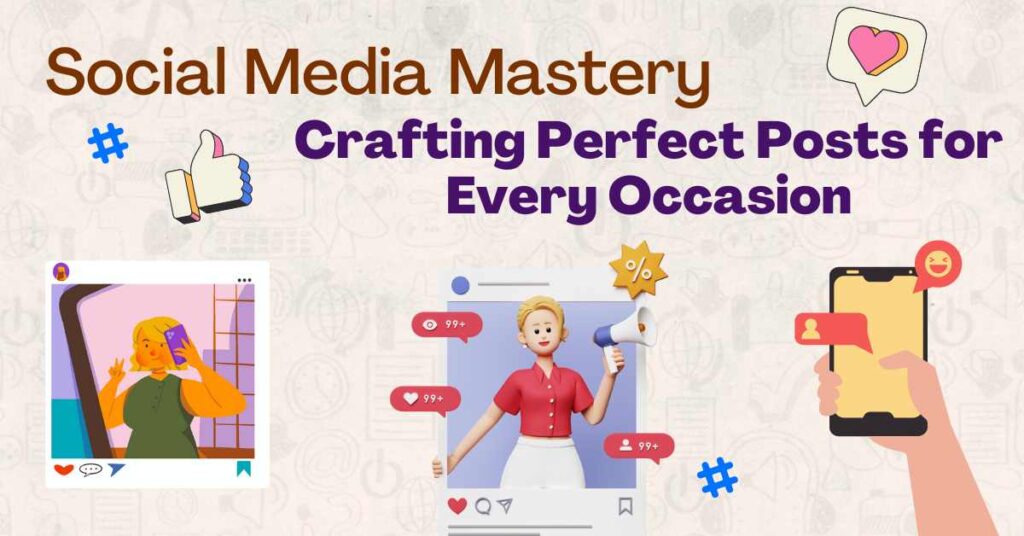Table of Contents
ToggleSocial Media Mastery: Crafting Perfect Posts for Every Occasion
In today’s world, being good at social media marketing is super important for everyone, whether you’re a regular person or a business. Making really great posts for every situation means you need to be creative, have a plan, and understand who you’re talking to. First, it’s really important to know who your audience is and what they like. Making your posts fit what they like will make more people interested and want to talk to you.
Pictures and videos are the best things to use on social media. They catch people’s attention more than just words. Also, posting at the right time when most people are online helps more people see your posts. But making a great post isn’t just about what it looks like or when you post it. The words you use are important too. If you tell a good story or keep your message short and clear, more people will pay attention.
Lastly, you need to look at how well your posts are doing. You can see how many likes, shares, and comments you get. This helps you understand what your audience likes and change your strategy if needed. With practice, you can get really good at social media marketing and make perfect posts for any occasion.
Understanding Your Audience: Tailoring Posts To Fit Their Preferences
Certainly! Here are some key insights on Understanding Your Audience and Tailoring Posts to Fit Their Preferences:
- Beyond Demographics: Understanding your audience goes beyond recognizing their age, location, or gender. While demographics provide a broad outline, the real intricacies lie in psychographics—the study of attitudes, interests, and behaviors that shape consumer decisions. Dive deep into your audience’s psychographics to truly know them.
- Creating Buyer Personas: Develop detailed buyer personas that represent different segments of your audience. These personas should include not only demographic information but also psychographic details. Use examples and tools to create relatable personas.
- Leveraging Data for Deeper Insights: Collect and analyze data to gain deeper insights into your audience’s preferences. Understand what content resonates with them, when they’re most active online, and what problems they need solutions for.
- Adapting Content Strategies: Tailor your content formats to align with audience preferences. Some may prefer long-form articles, while others might enjoy short videos or infographics. Adapt your tone and style to match their preferences as well.
- Audience Segmentation and Personalization: Elevate the customer experience by segmenting your audience and personalizing your content. Craft messages that resonate with specific groups, addressing their unique needs and interests.
- Social Media Listening: Tap into online conversations through social media marketing listening. Understand what your audience discusses, their pain points, and their sentiments. Utilize social media listening tools to stay informed
Remember, successful marketing hinges on understanding your audience deeply and tailoring your approach accordingly. By doing so, you’ll create meaningful connections that foster engagement and loyalty
The Power Of Visuals: Utilizing Images And Videos To Enhance Engagement
- Capturing Attention: Visual content, such as images and videos, grabs attention faster than plain text. When users scroll through a sea of information, compelling visuals act as magnets, drawing them in.
- Emotional Connection: Images evoke emotions and tell stories. A well-chosen image can resonate with your audience, creating a deeper connection. Whether it’s a powerful photograph or an eye-catching illustration, visuals add an emotional touch.
- Breaking Text Monotony: Long paragraphs can be daunting. Visuals break up the monotony, making your content more digestible. Infographics simplify complex ideas, while videos provide dynamic explanations.
- Enhancing Storytelling: Visuals enhance storytelling. They allow you to convey messages beyond words. A poignant image can speak volumes, leaving a lasting impression on your readers.
- Social Media Impact: Posts with visuals receive more likes, comments, and shares. Social media thrives on eye-catching content. Use images and videos strategically to boost engagement.
Remember, visuals aren’t just decoration; they’re powerful tools that elevate your content and foster meaningful connections with your audience.

Timing Is Key: Strategic Scheduling For Maximum Impact
Strategic timing is a critical factor in maximizing the impact of your efforts, whether it’s in public relations, marketing, or other areas. Here are key points to consider when scheduling events or messages:
- Align with Industry Trends: Keep an eye on industry-specific events, conferences, and emerging trends. Timing your PR events or product launches to coincide with these can help you tap into an audience that’s already interested in your field.
- Seasonal Considerations: Depending on your industry and product/service, seasons can significantly impact timing. For instance, launching a new line of winter clothing in late summer can build anticipation among consumers.
- Avoid Clutter: Analyze competitors’ PR calendars and industry noise. Avoid scheduling your event during periods when there’s an information overload. Stand out by choosing quieter moments.
- Engage in Thoughtful Storytelling: Sometimes, timing isn’t just about the date; it’s about creating a narrative that resonates with current events. If your product aligns with a topical issue or trend, your PR event can gain more attention.
- Build Anticipation: Consider a pre-event strategy—teasers, sneak peeks, and exclusive behind-the-scenes content can generate excitement and ensure a larger audience when the event takes place.
Crafting Compelling Content: Tips For Writing Captivating Captions And Messages
Crafting captivating captions and messages is an art that can significantly enhance your content’s impact. Here are some essential tips to create engaging and memorable captions:
- Understand Your Audience: Before penning down any caption, delve into your audience’s preferences, interests, and pain points. Tailor your message to resonate with their needs and emotions.
- Concise and Clear: Captions should be concise yet informative. Avoid verbosity; instead, focus on clarity. Use simple language that everyone can understand.
- Invoke Emotions: A powerful caption evokes emotions. Whether it’s humor, nostalgia, or inspiration, aim to strike a chord with your audience. Make them feel something.
- Tell a Story: Captions are more than mere descriptions. They’re an opportunity to narrate a story. Share anecdotes, personal experiences, or behind-the-scenes glimpses to create a connection.
- Include a Call-to-Action (CTA): Encourage engagement by adding CTAs. Whether it’s asking for comments, likes, or shares, guide your audience on what to do next.
- Use Relevant Hashtags: Hashtags increase discoverability. Research relevant ones and incorporate them into your captions. But don’t overdo it—quality over quantity.
- Be Authentic: Authenticity builds trust. Let your brand’s voice shine through. Whether it’s witty, professional, or heartfelt, stay true to your identity.
Remember, captivating captions are like magnets—they draw your audience in and keep them engaged. Craft them thoughtfully, and watch your content thrive.
Analyzing Success: How To Measure The Effectiveness Of Your Social Media Posts?
Certainly! Here’s a concise guide on measuring the effectiveness of your social media posts:
Engagement Metrics: These metrics reveal how well your audience interacts with your content. Keep an eye on:
- Engagement Rate: Calculate the percentage of reactions, comments, and shares relative to your audience size. It reflects content resonance and can influence algorithm reach.
- Click-Through Rate (CTR): Measure the proportion of clicks on your post links. Higher CTR indicates compelling content.
Reach and Impressions:
- Reach: The number of unique users who saw your content. It gauges your potential audience.
- Impressions: Total views, including multiple views by the same user. It helps assess visibility.
Conversion Metrics:
- Conversion Rate: Track how many users take desired actions (e.g., sign-ups, purchases) after engaging with your posts.
- Attribution: Understand which posts contribute to conversions. Use UTM parameters or tracking pixels.
Content-Specific Metrics:
- Likes, Shares, and Comments: Indicators of content quality and audience interest.
- Hashtag Performance: Monitor how well your branded or campaign-specific hashtags perform.
- Video Views: Assess video content engagement.
Audience Metrics:
- Follower Growth: Steady growth indicates content resonance.
- Audience Demographics: Understand your audience’s age, location, interests, etc.
Tools and Dashboards:
Use analytics tools like Facebook Insights, Google Analytics, or social media marketing management platforms.
Set up customized dashboards to monitor key performance indicators (KPIs).Remember, analyzing social media success isn’t just about vanity metrics. It’s about aligning your efforts with business goals and adapting your strategy based on insights
Frequently Ask Question
- Social media marketing is the use of social media platforms to promote products or services, build brand awareness, and engage with audiences.
- Social media marketing helps businesses reach a wider audience, increase brand visibility, drive website traffic, and foster customer relationships.
- Benefits include increased brand awareness, improved customer engagement, enhanced customer loyalty, and potentially higher conversion rates.
- Focus on platforms where your target audience is most active. Popular options include Facebook, Instagram, Twitter, LinkedIn, and TikTok.
- Metrics such as engagement rate, reach, impressions, click-through rate, and conversions can help measure campaign effectiveness.
- Avoid overposting, ignoring audience engagement, inconsistent branding, and not tracking analytics.
- Conduct market research, analyze demographics, and use social media analytics tools to identify and understand your target audience.
- Visual content such as images and videos tend to perform well, along with engaging and interactive content like polls, quizzes, and live streams.
- Engage with your audience by responding to comments, asking questions, running contests, and sharing user-generated content.
- Define your goals, know your audience, create compelling content, stay consistent, and track your results to refine your strategy over time.


